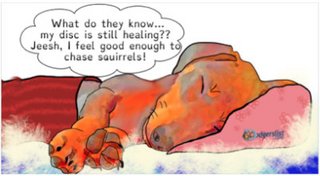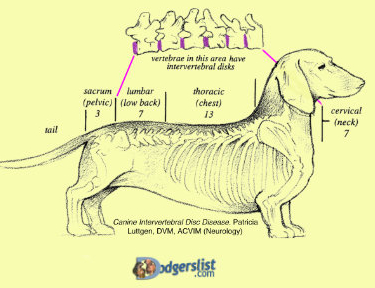Welcome! We are a small group and go by first names. Mine is Paula, what's yours?
PAIN- report ASAP to your vet!Your reports of pain today when not supported correctly when lifted, should be reported to the vet. All the painful swelling (if this is a disc episode) has not yet been fully resolved by the anti-inflammatory meloxicam. It can possibly take any anti-inflammatory about 7-30 days to fully resolve inflammation. The 9-day meloxicam Rx ends today (5/30). Meloxicam's stop is to find out if another course is needed or not. Pain when lifted even while there is still one pain med being given (gabapentin), seems to indicate another course of Meloxicam might be needed.
Advocate for Meloxicam, pain meds, Pepcid AC. Learn more about how anti-inflammatory drugs like Meloxicam are used during a disc episode:
dodgerslist.com/2020/04/18/steroids-vs-nsaids/Until you have a good diagnosis that says you are not dealing with a current disc episode, act as if this IS a disc episode by doing STRICT rest. You have reported current
pain and
nerve damage in the tail.
Let us know you are on the same page about STRICT rest:
If your dog moves around too much, the disc in the lower back area cannot heal.
With pain medications to mask pain, dogs will not be in pain and want to be more active. So it is up to you to restrict your dog’s activity for them.
Crate rest is to PREVENT the disc from worsening during the healing period which in turn could severely affect the spinal cord and damage those nerves!
 **
** STRICT rest means:
- no laps - no couches
- no baths - no sleeping with you
- no chiro therapy - no meandering at potty times.
- Tips/ideas to be successful with STRICT REST:
dodgerslist.com/2020/05/14/strict-rest-recovery-process/ - Inside of a recovery suite except for potty time and urgent vet care. Vehicle transports can be a potential for too much movement of the back disrupting the scar formation on the disc. Seeing the neuro to get a firm diagnosis from a higher authority would be a benefit overriding potential risk of too much movement. Having the correct diagnosis means the correct treatment can be applied.
WHAT DATE is the neuro appt?
 **
**
With urgent vet visits, secure the crate in your vehicle. Transport carefully using a crate padded out with rolled up towels on either side of the dog to prevent movement or jarring the spine when braking or turning corners.
POTTY TIMES
Carry to and from the recovery suite to the potty place and then allow a very few limited footsteps.
Using a sling (long winter scarf, ace bandage, belt) will save your back and help to keep a wobbly dog's back aligned and butt from tipping over.
A harness and 6 foot leash is to control speed and keep footsteps to minimum as you stand in one spot.
An ex-pen in the grass is an excellent alternative to minimizing footsteps with the physical and visual to indicate there will be no sniff festing going on!
STOMACH PROTECTION is necessary for the duration of any anti-inflammatory including Meloxicam
Dogs don't speak up at first signs of trouble like a person would. Red flag signs can progress from nausea> vomit> loose stool>.... Bleeding ulcers (red or black blood in diarrhea) can turn to a life-threatening perforated stomach lining. LEARN MORE about the factors that can increase stomach acids: dodgerslist.com/2020/05/06/stomach-protection/
FIRST do ask your vet in this very, very particular way...
--Is there a medical/health reason my dog may not take Pepcid AC (famotidine)?
--Doesn’t need it, we wait til there is problem…are NOT answers to your question!
--The dose of famotidine may require reduction in patients with liver or kidney disease.
-- It may be prudent with heart patients to choose another class of acid reducer.
Pepcid AC (famoditine) is available for purchase at grocery stores:
The usual dose of Pepcid AC (famotidine) for dogs is 0.44mg per pound.
--Give 30 mins before the anti-inflammatory.
--Dose thereafter every 12 hours for as long as your dog is on the anti-inflammatory.
Info you should know about:XRAYS
X-rays do not confirm a disc episode. X-rays can help to suspicion a disc episode. Most diagnosis are made with hands on exam, the breed of the dog, dog's history. X-rays show only the hard tissue, not soft tissue of discs and spinal cord. X-rays are mostly used to rule out other suspicious diseases such as tumors, broken bone luxations, discospondolyitis, congenital abnormalities, etc.
BREEDS
Disc disease occurs most commonly in small breed dogs such as the dachshund, Pekingese, shih tzu, toy or miniature poodle,
cocker spaniel, basset hound, Chihuahua,
bichon and beagle.
TAIL nerve damage
We are not vets and we do not diagnose. Having some info before you consult with a neuro would be useful in asking good questions and gaining better perspective on what the neuro explains if this is, indeed a disc episode or if another disease.
The neck C1-7, Chest T1-13, low back L1-7, pelvic S1-3
To add to the complexity there are two kinds of IVDD. Short summary:
Hansen Type I The prematurely aged disc degeneration is typically complete by two years of age. Vets and owners, however do not know the dog was born with IVDD until most typically at age 3-7 years old with the first signs of pain. Type I can happen earlier. My doxie had back surgery at age one! And on the Forum many small dwarfed legged breeds have been diagnosed at older ages.
Hansen type II disc disease in dogs is more similar to the normal aging process of disc disease in humans. Type II is more chronic in nature and most often occurs in older, non-chondrodystrophic (not dwarf legged) canine breeds.
You may find it helpful to get an overall view of IVDD in this 10 min presentation to orient yourself before the neuro appt.
Shortcut Thru IVDD:
dodgerslist.com/2020/06/26/time-and-ivdd/ Fill us in a bit more on the current meds as well as if there are any adjustments to any other meds: ?mg ?x/day f
or how many days Rx'd
-- gabapentin:
how many mgs is each dose given every 8 hrs (3x/day)





